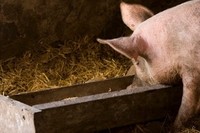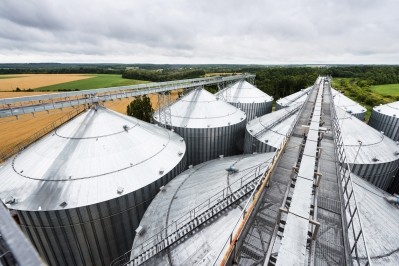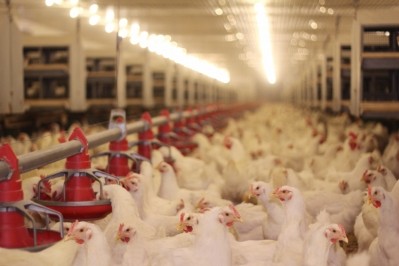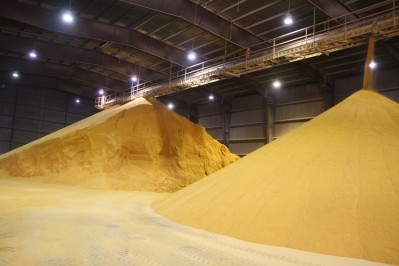Enzyme cocktail improves feed digestibility, boosts gut bacteria growth

A team of researchers working with the University of Manitoba in Canada explored the use of supplemental enzymes in distillers dried grains with solubles diets (DDGS). The group published their results in the journal Animal Feed Science and Technology.
“The first objective of this study was to evaluate the effect of supplementing a diet containing 30% DDGS with MC on coefficients of apparent ileal (CAID) and total tract (CATTD) energy and nutrient digestibility,” said the research team. “The second objective was to test the hypothesis that addition of MC to a DDGS-containing diet will stimulate the growth of fiber-fermenting bacteria and volatile fatty acid (VFA) production.”
The multi-enzyme cocktail (MC) was found to improve pig digestion and make some nutrients more accessible, they said.
“In conclusion, adding MC to the DDGS diet improved the digestibility of DM [dry matter], starch, most AA [amino acids], but not NDF [neutral detergent fiber] and N [nitrogen] digestibility,” they said. “The results show that addition of MC to the DDGS diet stimulated the growth of intestinal bacteria with xylanolytic and cellulolytic activities.”
Why supplemental enzymes?
Distillers dried grains with solubles (DDGS) offer an inexpensive ingredient for the composition of swine diets, said the researchers. The feed item is a by-product of the ethanol industry and includes a high nutritional aspect.
However, it also has a large non-starch polysaccharides (NSP) factor and has been found at times to reduce energy and nutrient uptake, they said. “Thus, exogenous enzymes (EE) have been used as a strategy to improve the nutritive value of diets containing DDGS in pigs (Kerr et al., 2013 and Swiatkiewicz et al., 2015),” they added.
But that treatment does not generate consistent results, potentially because of the fiber structure in the DDGS, said the researchers. A different enzyme combination may be needed to hydrolyze the fiber and improve nutrient availability.
In vitro experiments have found that oligosaccharides can be fermented by intestinal bacteria and that bateroides can break down xylans, they said. Also, cereal grains with large NSP amounts can prompt the growth of acetate-producing cellulolytic bacteria and xylanolytic bacteria.
DDGS fiber is insoluble because of its arabinoxylans, cellulose and lignin content, they said. But, some enzymes may degrade those factors and stimulate microbial metabolite production.
“Therefore, addition of EE to DDGS-containing diets is expected to generate oligosaccharides that will promote the growth of cellulolytic and xylanolytic bacteria and volatile fatty acids (VFA) production,” they said.
But little data documents the influence of a multi-enzyme cocktail (MC) on a diet containing DDGS and the subsequent interaction with the gut microbial profile and microbial metabolites.
The study
In the experiment, a group of cannulated pigs were given a series of trial diets, said the researchers. Each diet was fed in a 2-period change over design for 16 days and a casein-cornstarch diet was used separately to establish base endogenous nitrogen (N) and amino acid (AA) losses and calculate standardized ileal digestibility (SID) of AA.
The diets included a control with corn and soybean meal, the diet with 30% DDGS (DDGS diet) and the DDGS diet with the multi-enzyme cocktail (DDGS+MC), they said. Illeal digesta and fecal matter were collected on days 15 and 16, and 13 and 14, respectively and tested for VFA and to determine the bacterial profile.
Fecal and digesta samples also were collected daily for digestibility assessment, they said. The CAID and CATTD of nutrients were calculated.
Results
The control diet had more starch and less NDF than either diet containing DDGS, said the researchers. But the experimental diets had a higher crude fat content.
AA levels, except for lysine, in the control diet were slightly above the DDGS diets, they said. The CAID for dry matter, N, energy and starch were higher for the control diet, but adding MC improved the CAID for DM, energy and starch.
The CAID of starch was the same for the control and DDGS+MC diets, they said. And, there was not alteration by diet of CAID for crude fat and NDF.
“The recoveries of xylanase, protease, and β-glucanase in DDGS + MC diet were 105, 111 and 85%, respectively of the targeted activities,” said the researchers. “The control and DDGS diets had <100 U/kg of xylanase and <50 U/kg of β-glucanase, whereas protease was 780 and <100 U/kg in the DDGS and control diets, respectively.”
The CATTD for DM and energy was improved for the diet getting the enzyme supplement when compared to the other DDGS diet, they said. The control diet had more CAID and coefficient for standardized ileal digestibility (CSID) indispensable and dispensable AA, but the MC additive did improve the DDGS did responses, except for histidine, methionine and threonine.
“The CATTD for crude fat tended (P < 0.10) to increase in pigs fed the DDGS-containing diets compared with those fed the control diet,” they said. “However, the CATTD for NDF tended (P < 0.10) to be greater in pigs fed the control diet than in those fed the DDGS and DDGS + MC diet.”
The DDGS+MC diet had the highest concentration of isovalerate in the ileal digesta, they said. The diet also had more Enterobacteriaceae and Bacteroides–Prevotella–Porphyromonas bacteria in their feces. Levels of firmicutes and beta-xyloxidase in the fecal matter of control diets pigs and pigs getting the enzyme treatment were similar, the researchers added.
Source: Animal Feed Science and Technology
Title: Nutrient digestibility, digesta volatile fatty acids, and intestinal bacterial profile in growing pigs fed a distillers dried grains with solubles containing diet supplemented with a multi-enzyme cocktail
DOI: published online before print:10.1016/j.anifeedsci.2015.12.006
Authors: A.K. Agyekum, A. Regassa, E. Kiarie, C.M. Nyachoti,














